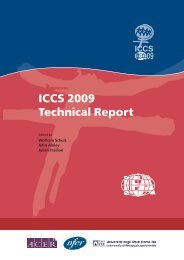Teacher Education and Development Study in Mathematics - IEA
Teacher Education and Development Study in Mathematics - IEA
Teacher Education and Development Study in Mathematics - IEA
You also want an ePaper? Increase the reach of your titles
YUMPU automatically turns print PDFs into web optimized ePapers that Google loves.
20<br />
TEACHER PAY AND STUDENT MATHEMATICS ACHIEVEMENT<br />
teacher labor force, but also the distribution of those skills across social class groups.<br />
In societies where <strong>in</strong>come is more equally distributed, teachers with high mathematics<br />
skills may be less averse to teach<strong>in</strong>g <strong>in</strong> schools conta<strong>in</strong><strong>in</strong>g students from lower social<br />
class levels than teachers <strong>in</strong> societies where <strong>in</strong>come is more variable because the social<br />
distance between the lower <strong>and</strong> the higher social classes is smaller. Another possibility<br />
is that, <strong>in</strong> societies with more equal <strong>in</strong>come distribution, classrooms vary less <strong>in</strong> terms<br />
of their teach<strong>in</strong>g conditions than is the case <strong>in</strong> more unequal societies. <strong>Teacher</strong>s of equal<br />
mathematics skills are thus more likely to be found across the spectrum of classrooms<br />
<strong>in</strong> the education system. And if we assume that higher teacher mathematics skills yield<br />
a higher payoff <strong>in</strong> classrooms with students from lower SES backgrounds, we can then<br />
also assume that countries with more equal distribution of teacher skills will have higher<br />
levels of average student mathematics performance.<br />
If teacher mathematics skills are, <strong>in</strong>deed, an important factor expla<strong>in</strong><strong>in</strong>g student<br />
performance <strong>in</strong> mathematics, we should f<strong>in</strong>d relationships between student<br />
mathematics performance on <strong>in</strong>ternational tests, such as TIMSS <strong>and</strong> PISA, <strong>and</strong> on<br />
measures of both GDP per capita (a proxy for the overall level of mathematics skills<br />
available <strong>in</strong> the labor market) <strong>and</strong> <strong>in</strong>come distribution. We should also f<strong>in</strong>d that,<br />
assum<strong>in</strong>g we control for GDP per capita <strong>and</strong> <strong>in</strong>come distribution, students have higher<br />
levels of mathematics performance <strong>in</strong> nations where teacher wages are higher relative to<br />
the wages of workers <strong>in</strong> mathematics-<strong>in</strong>tensive professions.<br />
We explore both these notions <strong>in</strong> the first part of this publication. We briefly summarize<br />
the results of our comparison across 20 countries of (estimated) teacher age/<strong>in</strong>come<br />
profiles for various years with the age/<strong>in</strong>come profiles of professionals <strong>in</strong> mathematics<strong>in</strong>tensive<br />
professions. When develop<strong>in</strong>g our estimates, we controlled for gender <strong>and</strong><br />
level of education. We found that, <strong>in</strong> many of the 20 countries, salaries of teachers are<br />
similar to those of professionals <strong>in</strong> mathematics-<strong>in</strong>tensive occupations. However, <strong>in</strong> the<br />
rema<strong>in</strong><strong>in</strong>g countries, this is not the case. (The 20 country studies comprise the second<br />
part of this report.)<br />
We also, <strong>in</strong> the first section of the report, estimate the relationship between student<br />
mathematics test scores on the TIMSS <strong>and</strong> PISA mathematics tests, GDP per capita,<br />
<strong>in</strong>come distribution, <strong>and</strong> teachers’ salaries relative to the salaries of people of the same<br />
gender with a similar level of education (usually completed university) who are employed<br />
or tra<strong>in</strong>ed as scientists. We use country as the unit of observation. The results of this<br />
analysis suggest that student performance is positively <strong>and</strong> statistically significantly<br />
related to relative teacher salaries <strong>in</strong> the case of male (but not female) teachers, even<br />
when controll<strong>in</strong>g for GDP per capita <strong>and</strong> <strong>in</strong>come distribution. We discuss these results<br />
<strong>and</strong> how they might <strong>in</strong>form cont<strong>in</strong>ued research on the effect that pay<strong>in</strong>g higher relative<br />
salaries to teachers potentially has on student mathematics performance.<br />
We need to caution that the results are essentially suggestive, not causal. As we po<strong>in</strong>t<br />
out <strong>in</strong> the conclusions, there are several possible reasons for the correlation between<br />
teachers’ relative pay <strong>and</strong> higher student performance, only one of which is that higher<br />
teacher pay draws <strong>in</strong>dividuals with higher mathematics skills <strong>in</strong>to teach<strong>in</strong>g, thereby<br />
result<strong>in</strong>g <strong>in</strong> better student performance.

















